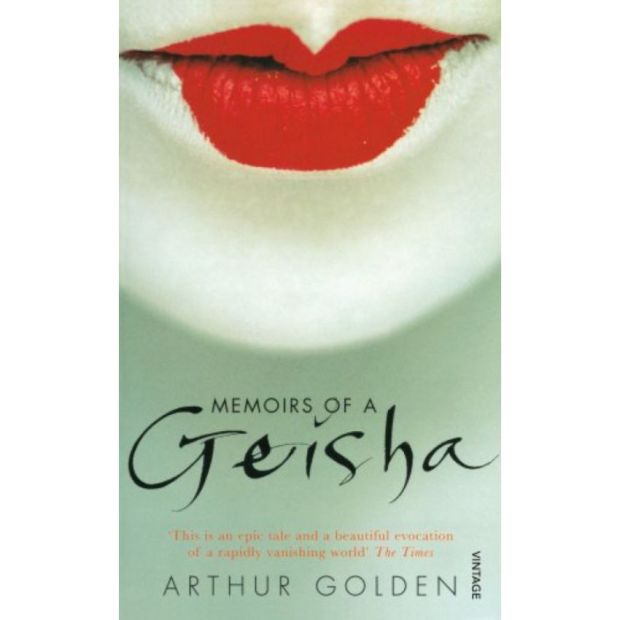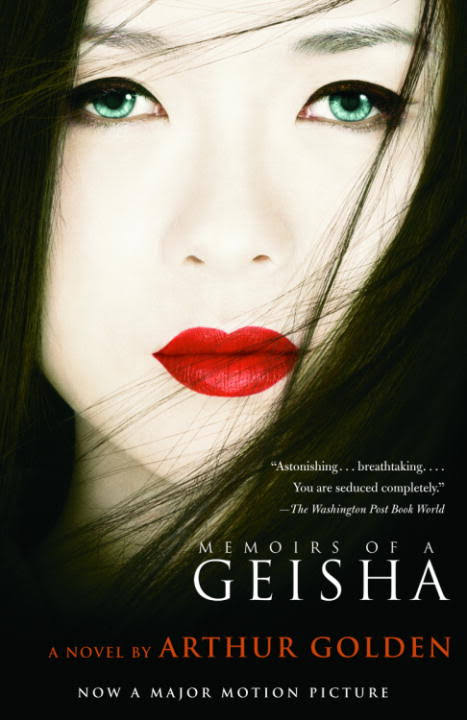Memoirs of Geisha is written by Arthur Golden which is a slow paced novel. I bought this novel as a result of my eagerness to know more about the Japanese Culture. I have heard my friends talking about so I thought I should read it. While I was reading it, I fell in the love with Arthur’s style of writing. Lets go in depth about the book:
Cover- The cover is white in color and has a face of girl with a red lipstick. It is believed Geisha’s mostly wear red lipsticks which gives us little sneak peaks of the novel.

Title- The title is Memoirs of Geisha. Usually, Memoir is a writeup where a person himself dies and the work is published post death. Thus, it suggests something like that.
Blurb- This story is a rare and utterly engaging experience. It tells the extraordinary story of a geisha -summoning up a quarter century from 1929 to the post-war years of Japan’s dramatic history, and opening a window into a half-hidden world of eroticism and enchantment, exploitation and degradation.
A young peasant girl is sold as servant and apprentice to a renowned geisha house. She tells her story many years later from the Waldorf Astoria in New York. Her memoirs conjure up the perfection and the ugliness of life behind rice-paper screens, where young girls learn the arts of geisha – dancing and singing, how to wind the kimono, how to walk and pour tea, and how to beguile the land’s most powerful men.

Plot- The plot is intriguing as it talks about the journey of Chiyo who is a simple girl and the way she goes through trials and tribulations in her life. This book talks about her Geisha times, her training, her love and in this journey how she loses herself and becomes Sayuri. There are no digressions in the plot.
Theme- In this book, we find theme of separation. When young Chiyo and Satsu are separated from their parents, it aches the hearts of the readers. Later on, we notice Chiyo and Satsu’s separation. Then there is separation of Sayuri from Motherin Okiya during the World War 2.
The other theme can be noticed is of War. The destructions led to Geisha’s decline. Americans overtook some of the Geisha properties. Even the well knowns became penniless. There is a long time gap.
The theme of Japanese Culture plays an eminent role in this book. This story is of Geisha which means a Japanese Girl who could dance, sing and entertain men. When they are novice, they are kept under Apprenticeship where an elder sister is given to them who teach them. Further, after being baptised, she is adopted by a teacher or a mother where she lives. And then she is married and her husband is known as Danna.
The theme of love lost and found is noticed. Till the end readers are confused, like who Sayuri loves, whether its Chairman or Nobu. But while studying carefully, we come to know that Sayuri loves Chairman and in the first part they are separated only to meet again in the end of the chapters. They have a tough journey to face.
Characterisation- Arthur Golden is well known for his character portrayal. There are so many characters which adds flavour to the story. Chiyo or Sayuri is the main protagonist whose journey is being delineated. It seems as if she herself is telling her story. When she gets separated by her family, it makes the readers shed tears and afterwards the struggle of becoming a Geisha could be noticed. During this course of journey she comes across Hatsumomo who is the antagonist in the play. She is the popular Geisha who hates Sayuri from the core of her heart. During this time, Mameha comes in picture and helps Sayuri. When Sayuri begins to taste popularity, Hatsumomo is jealoused and soon leaves the site due to some reasons. Nobu is an amazing character who is always ready to support Sayuri but Sayuri feels for chairman. All the characeters are interlinked. Even the Minor characters play a significant role in plot construction.
Style- The author has a different style of writing. His novel is slow paced and has traces of Dickensian style. He has a unique way of storytelling. He adds all the elements starting from the minute details. The novel is written in first and third person narrative with vivid descriptions especially the indirect ones. A lot of Japanese words are being used since it highlights the post war elements and Japanese culture like : kimono, kyoto, danna, gion etc.
Negatives- Arthur Golden’s novel is a part of Vintage collection hence, it has a long length of around 435 pages which becomes difficult to complete in one day. Further, the slow pace of the novel might cause lack of interest in it. There are so many Japanese jargons which we might not know and we need to refer google or dictionaries for that. Moreover, there are too many characters which sometimes causes haush paush and readers might get confused.
Others reviews:
Golden’s storytelling is rich and slow-paced. Like Austen, he lavishes attention on the minute details that regulate and define social distinctions. In the raising of a teacup or an eyebrow there are worlds of implication. The prose style is simple and strangely satisfying, perfectly attuned to its time and place. Golden manages to find the simile for every occasion. “That startling month in which I first came upon the Chairman again…made me feel like a pet cricket that has at last escaped its wicker cage. For the first time in ages I could go to bed at night believing that I might not always draw as little notice in Gion as a drop of tea spilled onto the mats.” Golden deftly makes use of a culture that deflects emotion and makes direct communication taboo to create a world of intrigue and romance. Depression and war remain in the background while Sayuri imbibes wisdom from her mentor, Mameha, battles her rival, Hatsumomo, and yearns for the attentions of the Chairman. Memoirs of a Geisha is an intelligent entertainment.
Dan Cryer – Salon
Cherry-blossom delicate, with images as carefully sculpted as bonsai, this tale of the life of a renowned geisha, one of the last flowers of a kind all but eliminated by WW II, marks an auspicious, unusual debut. Japan is already changing, becoming industrialized and imperialistic, when in 1929 young Chiyo’s fisherman father sells her to a house in Kyoto’s famous Gion district. The girl’s gray-eyed beauty is startling even in childhood, so much so that her training is impeded by the jealousy of her house’s primary geisha, the popular, petty Hatsumomo. Caught trying to run away, Chiyo loses her trainee status until taken under the wing of Mameha, a bitter rival of Hatsumomo.
Chiyo flourishes with Mameha as her guide, soon receiving her geisha name, Sayuri, and having her mentor skillfully arrange the two main events vital to a geisha’s success: the sale of Sayuri’s virginity (for a record price), and the finding of a sugar-daddy to pay her way. Seeing the implications of Japan’s militarism, Mameha pairs Sayuri with the general in charge of army provisions, so that as WW II drags on she and her house have things no one else in Gion can obtain. After the war, with her general dead and others vying for her attention, Sayuri pines anew for the only man she ever loved—an electrical-corporation chairman whose kindness to a crying Chiyo years before altered the course of her future.
Though incomparable in its view of a geisha’s life behind the scenes, the story loses immediacy as it goes along. When modern times eclipse Gion’s sheltered world, the latter part of Sayuri’s life—compared to the incandescent clarity of its first decades—seems increasingly flat.
Kirkus Reviews
Availability- https://www.amazon.com/Memoirs-Geisha-Novel-Arthur-Golden/dp/0679781587
https://itunes.apple.com/us/movie/memoirs-of-a-geisha/id270980737
http://www.whsmith.co.uk/products/memoirs-of-a-geisha/9780099771517
http://www.ebay.com.au/bhp/memoirs-of-a-geisha